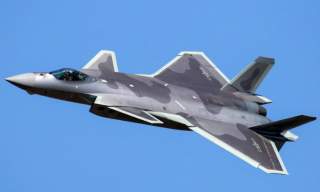Why China's J-20 Is A Problem For America (And It Has Zero to Do with Stealth)
During the performance, the J-20 opened its missile bay doors to reveal four PL-15 missiles accompanied by two PL-10 missiles on either side.
Key point: The J-20’s two side-mounted PL-10 missiles, while less conspicuous than their long-range counterpart, are a key factor in the J-20’s operational versatility.
The Chinese People’s Liberation Army Air Force made waves at the 2018 Zhuhai Airshow with the latest showing of their flagship fifth-generation stealth fighter, the J-20.
As is common with airshow coverage, large swaths of the ensuing commentary focused on the J-20’s handling and maneuverability as it performed a series of rolls and a climb. But this elides what is perhaps the most significant aspect of the J-20’s Zhuhai showing: its weapons system.
During the performance, the J-20 opened its missile bay doors to reveal four PL-15 missiles accompanied by two PL-10 missiles on either side. The PL-15 is a long range air-to-air missile slated to enter service in 2018. Outfitted with an active electronically scanned radar and featuring a reported maximum range of up to 300 km, the PL-15’s impressive specifications place it in the ranks of the top air-to-air missiles along with the European Meteor missile and Russian K-37M.
The PL-15’s effective range in actual aerial engagements is certain to be lower than the maximum range 300 km, but is nonetheless much higher than its American AIM-120 AMRAAM counterpart’s estimated 180 km or less. American general Herbert Carlisle voiced serious concerns in 2015 when the development of the PL-15 entered the public knowledge: “Look at our adversaries and what they’re developing, things like the PL-15 and the range of that weapon.” General Carlisle raised the same issue in an interview with FlightGlobal: “The PL-15 and the range of that missile, we’ve got to be able to out-stick that missile.”
The American F-22 and F-35 fighters are now equipped with the latest AIM 120-D missiles, but a massive range deficit remains nonetheless. The challenge of the PL-15 comes on the heels of questions about the uncertain future of the aging AMRAAM system. As Captain James Stoneman put it to the National Interest: “Currently there is no program of record for a follow-on… we’ve probably close to maxing it out.” Development of the latest Block III iteration of the short range AIM-9X was cancelled, and Raytheon struggles with a necessary AMRAAM refresh.
The J-20’s two side-mounted PL-10 missiles, while less conspicuous than their long range counterpart, are a key factor in the J-20’s operational versatility. A short-range infrared air-to-air missile, the PL-10 can be fired at off boresight angles of 90 degrees using the J-20’s Helmet Mounted Display (HMD). In other words, the PL-10’s on the J-20 can be fired in the direction that the pilot points their head.
Off boresight targeting is by no means a new technology. In fact, the PL-10 is China’s response to the AIM-9X Block II Sidewinder short range missiles that the United States is selling to Taiwan. There is no reliable information on the PL-10’s range at the time of writing, but it is expected to at least match AIM-9X’s reported maximum range of 20-22 km. Iterative performance differences aside, it is a bigger long-term concern is that the PL-10 and PL-15 are reportedly built with the latest anti-jamming technology at a time when the AIM- 9X and AIM-120D are perceived as increasingly vulnerable to modern digital radio frequency memory (DRFM) jamming techniques.
There is much that is still unknown about the J-20, including its launch mechanism and the final specifications of its WS-15 engine currently in development. It remains to be seen if this particular armament configuration makes it into the regular production process, but the juxtaposition of the PL-15 and PL-10 inside the J-20’s frame can become a stark concern for the United States and some of its regional allies who continue to rely on aging AMRAAM technology.
Mark Episkopos is a frequent contributor to the National Interest and serves as a research assistant at the Center for the National Interest. Mark is also a PhD student in History at American University. This article first appeared earlier this year. Image: Creative Commons.

